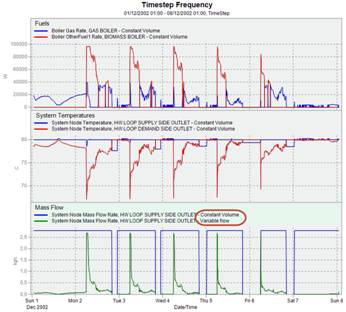EnergyPlus is an extremely powerful simulation engine that provides access to the most commonly required simulation capabilities relating to fabric, thermal mass, glazing, shading, renewables, HVAC, and financial analysis. But with DesignBuilder EnergyPlus, you don't have to be an expert to use it. Let DesignBuilder do the hard work for you.
Simulation key features
- EnergyPlus is tightly integrated within this module providing advanced dynamic thermal simulation at sub-hourly timesteps.
- Provide accurate environmental performance data such as energy consumption, carbon emissions, room comfort at annual, monthly, daily, hourly, and sub-hourly intervals.
- Report solar gains on surfaces, surface temperatures and radiant exchanges.
- Access an extensive range of results for buildings and systems.
- Assess passive performance, thermal mass, and temperature distribution.
- Assess summer overheating performance, including CIBSE TM52 and TM59 for Part O calculations.
- Export surface temperatures and airflow rates as boundary conditions for detailed CFD analysis.
- Size heating and cooling systems.
- Assess building operational and whole-life cycle costs using industry standard calculation methods.
Unparalleled Simulation Flexibility and Documentation
Most competing tools use a "black box" approach to simulation, meaning that you get no access to the raw simulation inputs, outputs and the code used to run the simulations, and so can never be really sure what is going on under the hood. DesignBuilder Simulations are different. With EnergyPlus you get full access to the source code and documentation which has been extensively tested by thousands of practitioners and academics. And when you need to model building facades, systems or operational modes that are not provided out of the box, you can customise your simulations to match the real case through a range of methods:
- Modify the simulation input files, either manually or automatically in a script (requires the Scripting module).
- Customise the simulation using EMS runtime scripting (requires the Scripting module).
- Modify the EnergyPlus source code (for the more confident modeller with software development experience).
No other mainstream simulation tool offers so much flexibility in an easy to use package.
Technical specifications
- Calculate heating and cooling loads using the ASHRAE-approved 'Heat Balance' method implemented in EnergyPlus. Design weather data is included and loads can be reported at the zone, sytem and plant levels.
- Run simulations of your model using real hourly weather data to check how the building would behave under actual operating conditions.
- Daylighting - models lighting control systems using photoelectric sensors in the zone and calculates savings in electric lighting. Choose from stepped or continuous dimming.
- Check the effects of design alternatives on the key design parameters such as annual energy consumption, overheating hours, CO2 emissions.
- Energy consumption broken down by fuel and end-use.
- Internal air, mean radiant and operative temperatures and humidity calculated.
- An extensive range of comfort outputs are provided including underheating and overheating hours distribution curves, ASHRAE 55 comfort criteria, Fanger PMV, PPD, CIBSE TM52 and TM59, ASHRAE and CEN adaptive comfort metrics and unmet load hours. And with the addition of the Scripting module you can create your own comfort outputs.
- Site weather data
- Heat transmission through building fabric including walls, roofs, infiltration, ventilation etc.
- Heating and cooling loads.
- CO2 generation.
- Environmental performance data is displayed without needing to run external modules or import data. Any simulations required to generate the data are started automatically.
- HVAC can be simulated using either Simple or Detailed options. Detailed requires the HVAC module
- DHW
- Natural ventilation can be modelled with the option for windows to open based on control schemes including mixed mode.
- Glazing systems including frames, dividers and reveals are modelled in great detail using the most accurate simulation algorithms available. Innovative facade systems such as electrochromic glazing, SageGlass and MicroLouvres can be simulated.
- Shading by louvres, overhangs and sidefins as well as internal and mid-pane blinds and baffles.
- Model glazed cavities such as double facades and Trombe walls.
- Dynamically varying vertical temperature gradients in tall spaces such as atria and for displacement ventilation systems.
- Architectural features such as columns, awnings and complex shading devices can be treated including the effect of shading and reflection.
- Parametric analysis screens allow you to investigate the effect of variations in design parameters on a range of performance criteria.
- The Simulation Manager allows you to run and control multiple simulations and view their results. Simulations can be run in parallel on the local machine or on a simulation server on the network. This allows a large number of simulations to be queued and run overnight and results picked up and analysed in the morning.
- Choose from a range of different EnergyPlus simulators including the current DOE executable release, the current DLL release and any interim releases made available by DOE. You can even access versions of EnergyPlus you have compiled yourself.
- EnergyPlus allows you to calculate energy and carbon savings through control of electric lights according to the availability of natural daylight. The daylight illuminance levels in a building depends on many factors, including sky condition, sun position, photocell sensor positions, location, size, and glass transmittance of windows, window shades and reflectance of interior surfaces. Reduction of electric lighting is calculated based on daylight illuminance level, illuminance set point, fraction of zone controlled and type of lighting control.
 Results Viewer
Results Viewer
The Results Viewer can be used to view results contained within EnergyPlus output files and compare with results from previous simulations. It allows any of the thousands of data reports that can be generated by EnergyPlus to be viewed alongside results from the same or previous simulations. When used for analysing detailed HVAC node conditions it can be a valuable tool to help understand HVAC system operation (see a sample of graphic output to the right).
Packages including EnergyPlus Simulation
Simulation is core functionality for most DesignBuilder applications and is is included in Energy Assessor Plus and all Architectural and Engineering packages

